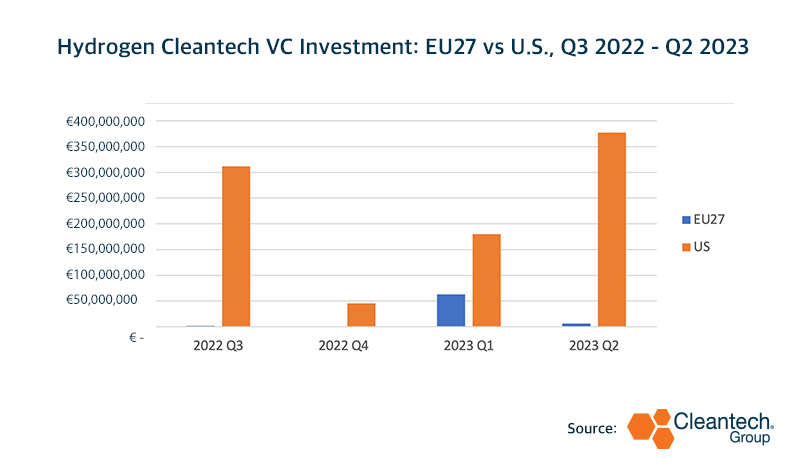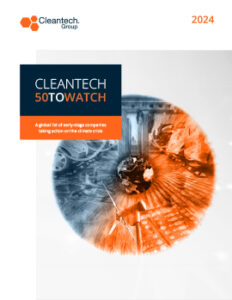Scaling Cleantech Manufacturing: A Look at the European Union’s Net-Zero Industry Act and the U.S.’ Inflation Reduction Act
The focal point of competition in the next few decades is cleantech, as digital was in the past 20 years. As the global race to net-zero greenhouse gas emissions heats up, the U.S. and EU are charging ahead to ramp up their cleantech manufacturing capacity and secure their long-term competitiveness.
In August 2022, the U.S. ushered in a new era of climate and industrial leadership with the adoption of the Inflation Reduction Act (IRA). The IRA provides a mixture of more than $369B in funds which will be delivered in the form of loans, loan guarantees, grants, and tax incentives to boost manufacturing of clean technologies in the U.S.
The IRA served as a wake-up call to Europe to propose the Net-Zero Industry Act (NZIA) in March 2023, setting forth the regulatory and investment conditions for Europe to foster, retain, and attract cleantech manufacturers and manufacturing capacity.
What is the NZIA?
The NZIA aims to make Europe the home of cleantech innovation by:
- Focusing on a list of strategic net-zero technologies based on their technology readiness level, contribution to decarbonization, and competitiveness and resilience of the energy system. These technologies are solar, wind, batteries and storage, heat pumps and geothermal energy, electrolyzers and fuel cells, biogas/biomethane, carbon capture, utilization and storage, and grid technologies, as well as their corresponding main upstream components (i.e., ingots, wafers and solar cells for solar modules, and towers and blades for wind turbines). This is only a draft list at this stage as the European institutions are still debating on which technologies should make the list.
- Providing enabling conditions for the wide deployment of these technologies. NZIA focuses on simplifying the permitting process for net-zero technology projects. This includes the establishment of one single point of contact per country for permitting purposes and putting forward detailed timeframes between 6-18 months for net-zero manufacturing projects’ permit approval.
- Facilitating access to markets. NZIA puts forward a list of requirements that public authorities will have to consider when assessing public procurement tenders or auction bids for net-zero manufacturing projects. One of these requirements mandates public authorities to give the tenders’ and bids’ sustainability and resilience contribution a weight of between 15% – 30% of the award criteria.
- Increased investment opportunities for net-zero projects. While the NZIA does not offer any fresh funding for net-zero technology projects, it provides for the repurposing of existing funding instruments to support the uptake of such projects. It also provides for the development of a bespoke platform, the so-called Net-Zero Europe Platform, where project promoters along with EU officials will discuss private sources of financing, investment needs, and existing financial instruments and EU funds.
- Introducing regulatory sandboxes to test net-zero innovation. NZIA envisions that these sandboxes will allow the development and testing of the technologies before their deployment into the market. The current text does not provide information on what kind of projects will be placed under these sandboxes or the benefits of such a placement.
- Accelerating CO2 injection capacity. NZIA proposes an EU-wide target annual CO2 injection capacity of 50 million tons in storage sites to be achieved by 2030. It also mandates EU oil and gas producers to contribute towards this target.
Currently, NZIA is being negotiated on what its final form should look like by the European Parliament and Member States. While there is not a fixed date on when the final form of NZIA will be passed, it is expected to be within the next six months.
Comparing the NZIA to the IRA
Both the NZIA and the IRA are about increasing domestic cleantech manufacturing capacity, yet they are completely different in how they seek to achieve a boom in domestic cleantech manufacturing.
While the NZIA is mostly regulatory, the IRA is essentially an enormous public investment that is transforming markets across most cleantech verticals.
Tax credits. The IRA’s primary tool consists of easily obtained tax credits for production and investment which are straightforward, transparent, uncapped, and inject directly into cleantech projects. As these tax credits are uncapped, some estimates (e.g., Goldman Sachs) put the total cost of the IRA at over $1T over 10 years (about $3,100 per person in the U.S.), making it the biggest climate bill ever by orders of magnitude – even dwarfing (yes, adjusted for inflation) historically transformative public investments such as the New Deal, the Marshall Plan, and the Great Society programs.
This is in stark contrast to the NZIA, where funding for projects will mainly come through grants. Tax credits are outside the purview of EU-policymakers in Brussels because taxation belongs with the various countries. Whereas companies must simply check boxes on a tax form to obtain public support in the U.S., companies in Europe must prepare a file that takes months or years and hundreds of hours of time – all for an uncertain outcome.
The IRA is designed to ‘speak’ to business. Its tagline is ‘private sector led, public sector enabled’. IRA tax credits are in place for 10 years, providing certainty to innovators and investors. Moreover, they are simple, predictable, and non-discriminatory, in contrast to corresponding EU schemes who have slow and cumbersome application processes. EU cleantech startups must apply to various programs that probably won’t select them after a monthslong application process and an even longer review period. For example, the chances of being selected for an EU Innovation Fund grant are 2%, and far lower for independent innovators.
Beyond tax credits. Beyond tax credits, the IRA is providing $11.7B in new federal funding to the U.S. Department of Energy’s (DOE) Loan Programs Office (LPO) – whose loans helped Tesla scale its manufacturing more than a decade ago – enabling it to unlock more than $312B in additional private sector investment. The LPO is proactively scouting innovators and engaging with them regularly. The LPO also makes loan guarantees, which are highly cost-effective. The IRA builds on the DOE’s recent evolution into an organization to support innovation past the early stage of technology development, giving it the resources to support large-scale demonstration and deployment capacities.
Finally, while the IRA overall contributes to making the U.S. market easier for cleantech firms to enter and navigate, the NZIA’s simplification of permitting will make it easier and faster to get projects off the ground in the EU, giving the EU a competitive advantage in a crucial pillar of cleantech competitiveness. This may also give the EU an advantage in terms of grid and charging infrastructure which facilitates the widespread uptake of cleantech.
Domestic content. Many of the IRA’s tax credits are conditioned on domestic content requirements. Combined with structurally higher energy prices in the EU, it is no surprise that the IRA’s tax credits are attracting European companies to develop new manufacturing projects in the U.S. (e.g., Northvolt, Volkswagen, and BMW announced new battery manufacturing projects). In Europe, domestic content requirements are still taboo, although some EU countries such as France are considering implementing them to reduce risky dependencies and spur innovation.
However, the world must make sure to avoid protectionist instincts that are a byproduct of industrial policy, because protectionist policies increase the cost of the transition, thereby slowing it down. It is, therefore, encouraging that the U.S. and EU plan to iron out trade frictions between them and enhance collaboration in cleantech, because it is indispensable to accelerating cleantech innovation so that emerging technologies scale, commercialize, and deploy widely in time for net-zero.
Impact on Cleantech
The IRA sparked a cleantech manufacturing industrial policy race that will accelerate the transition. The first results of the IRA impact are already visible in the U.S. Following the passage of the IRA, the Solar Energy Industries Association (SEIA) reported a solar investment exceeding $100B and highlighted that recent announcements of solar manufacturing facilities are expected to create employment opportunities for over 20,000 individuals.
The White House has monitored private investments surpassing $70B in U.S. manufacturing facilities aimed at bolstering the electric vehicle supply chain. In Europe, since March 2023, state subsidies of around €6.9B of cleantech investments have been approved.
Scaling Green Hydrogen

One of the key sectors where the IRA’s impact is visible is green hydrogen. The IRA offers a tax credit of up to $3/kilogram of clean hydrogen produced by a qualified green hydrogen facility. On top of the tax credits, the Bipartisan Infrastructure Law offers $9.5B in funding for clean hydrogen initiatives.
The EU launched an auction to help scale up Europe’s green hydrogen industry by reducing the cost gap between renewable and fossil fuel hydrogen production. The funding earmarked for this auction is €800M.
In the first quarter of 2022, venture capital funding for clean hydrogen projects peaked in the EU at €343M, over three times the amount funded in the U.S. However, since the IRA came into force, U.S. venture investment in green hydrogen has surpassed EU investment in every quarter, with U.S. spending totaling €1.2B more than in the EU in the first year since the IRA. Moreover, U.S. venture investment into green hydrogen is expected to soar further once U.S. regulators finalize rules around so-called “additionality” criteria, giving investors regulatory clarity over which projects are eligible for tax credits.



